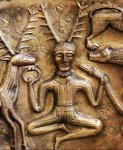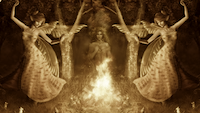Ancient European alternatives for Yoga
Home » Articles and News » Ancient European alternatives for Yoga
While yoga originates from ancient Indian traditions, there are some European ancient practices that can be seen as alternative forms of physical and spiritual disciplines. Although they may not have the same recognition as yoga, they share similarities in terms of promoting physical well-being, mindfulness, and connection with the self. Here are a few examples:
Greek: Ancient Greeks valued physical fitness and practiced various forms of gymnastics. These exercises, performed in the gymnasium, aimed to cultivate strength, agility, and grace. Greek gymnastics also incorporated philosophical teachings, emphasizing the harmonious development of the body and mind.
 Roman Baths: In ancient Rome, bathing rituals were considered important for both physical and spiritual purification. The Roman baths included activities such as hot and cold water immersion, massage, and communal socializing. These practices were seen as a way to cleanse the body and restore balance.
Roman Baths: In ancient Rome, bathing rituals were considered important for both physical and spiritual purification. The Roman baths included activities such as hot and cold water immersion, massage, and communal socializing. These practices were seen as a way to cleanse the body and restore balance. Druid Practices: The Druids, ancient Celtic priests and wise individuals, had spiritual practices that involved communing with nature, performing rituals, and cultivating wisdom. While specific details of their practices are not extensively documented, connecting with the natural world and the cycles of the seasons were central aspects of their spiritual path.
Druid Practices: The Druids, ancient Celtic priests and wise individuals, had spiritual practices that involved communing with nature, performing rituals, and cultivating wisdom. While specific details of their practices are not extensively documented, connecting with the natural world and the cycles of the seasons were central aspects of their spiritual path.Norse Practices: The ancient Norse culture had a deep reverence for nature and the elements. Their spiritual practices involved rituals, meditation, and a connection with the natural world. The runes, an ancient Norse alphabet, were also used for divination and self-reflection.
 Sacred Dance and Rituals: Throughout European history, various forms of sacred dance and rituals were practiced as a means of connecting with the divine and expressing spirituality. These dances often incorporated repetitive movements, rhythm, and symbolic gestures to induce trance-like states and spiritual experiences.
Sacred Dance and Rituals: Throughout European history, various forms of sacred dance and rituals were practiced as a means of connecting with the divine and expressing spirituality. These dances often incorporated repetitive movements, rhythm, and symbolic gestures to induce trance-like states and spiritual experiences.
Ancient European practices may not have survived in their original form or have as extensive a documented tradition as yoga. However, they provide examples of alternative physical and spiritual practices from European cultures that aimed to promote well-being, mindfulness, and a connection with the self and the natural world.
Ancient European ecstatic postures refer to specific bodily positions or stances that were used in various ancient European cultures during rituals, ceremonies, and religious practices to induce altered states of consciousness, trance, or ecstasy. These postures were believed to facilitate a connection with the divine, the spirit world, or to enhance the practitioner’s mystical experiences. While specific postures and their interpretations varied across different cultures and time periods, some common examples and characteristics include:
The Seated Posture: Sitting cross-legged or in a specific position with the spine straight was a common posture. It allowed for a stable and comfortable position during extended meditation or trance-inducing rituals.
The Supine Posture: Lying on one’s back with arms and legs stretched out is another example. This posture symbolized receptivity to spiritual experiences and contact with the divine.
The Fetal Posture: Curling up in a fetal position, often with arms around the knees, symbolized a return to the womb and rebirth. It was believed to facilitate the practitioner’s connection with the cycle of life, death, and rebirth.
The Dancing Posture: Certain dances or movements were used to enter ecstatic states. These movements often involved repetitive, rhythmic motions, helping practitioners enter an altered state of consciousness through physical exertion.
The Standing Posture: Standing with the arms raised or outstretched was another common way to connect with the divine. This posture symbolized openness and readiness to receive spiritual insights.
The Swaying or Spinning Posture: Some cultures used swaying or spinning motions to induce altered states of consciousness. The spinning movement, in particular, could lead to a sense of dizziness and disorientation, which was believed to open a doorway to the spiritual realm.
The Mudra Posture: Hand gestures and positions, known as mudras, were often used to focus the mind and invoke specific energies or deities. Mudras could be combined with other postures for a more profound spiritual experience.
These ecstatic postures were often combined with other elements, such as chanting, drumming, fasting, and the use of psychoactive substances, to enhance their effectiveness in achieving altered states of consciousness. While these practices were prevalent in various ancient European cultures, including the Celts, Germanic tribes, and pre-Christian Slavic and Baltic peoples, their exact details and significance may have varied from region to region. Today, researchers and modern practitioners have attempted to reconstruct and understand these ancient practices to gain insights into the spiritual and religious beliefs of the past.
Home » Articles and News » Ancient European alternatives for Yoga
